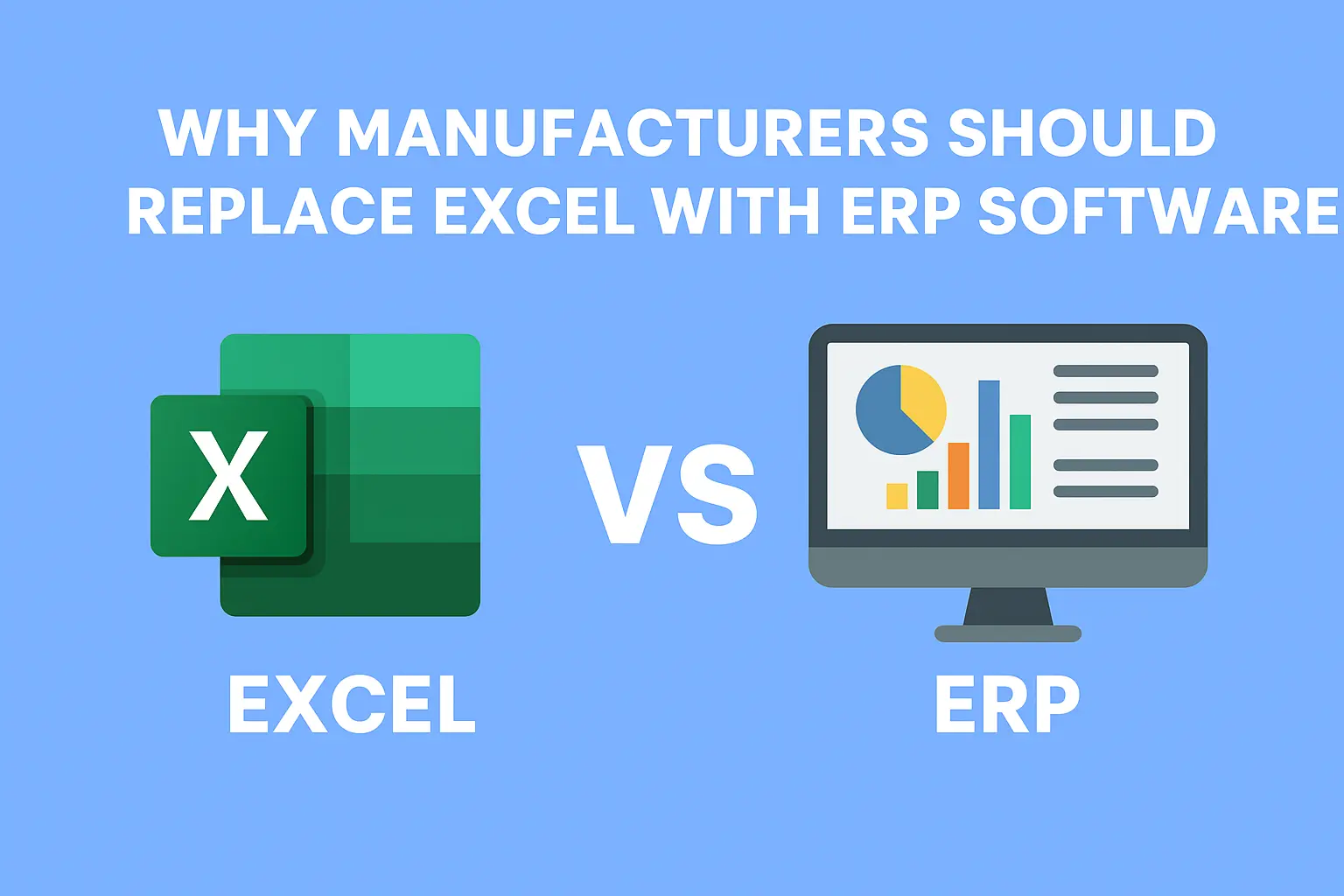Why Manufacturers Should Replace Excel with ERP Software
Many small and medium manufacturers still use Excel to run production, inventory, and quality processes. While familiar, Excel has limits — and those limits cost time, money, and compliance headaches. This article explains why switching to an ERP is the smarter long-term choice.

Introduction: Excel’s Limits in Modern Manufacturing
For decades Excel spreadsheets helped manufacturers track lists and do simple calculations. As operations scale, spreadsheets quickly become a liability—version confusion, formula errors, slow reporting, and limited traceability. ERP (Enterprise Resource Planning) software centralizes processes, automates workflows, and gives real-time visibility across the business.
1. The Hidden Costs of Managing Manufacturing in Excel
Many businesses underestimate the true cost of running on spreadsheets. Typical hidden costs include:
- Time Drain: Hours spent reconciling versions and consolidating reports.
- Error Risk: Mistyped formulas and manual transfers cause miscounts and rework.
- Version Confusion: Multiple "master" files create conflicting datasets.
- Poor Traceability: Auditors require change history and document control—difficult in unmanaged spreadsheets.
2. ERP vs Excel — Side-by-Side Comparison
| Feature | Excel | ERP Software |
|---|---|---|
| Data accuracy | Prone to manual errors | Centralized, validated data |
| Collaboration | File sharing and email | Real-time, multi-user access |
| Scalability | Becomes unmanageable | Designed to scale |
| Compliance | Manual tracking | Audit trails & document control |
| Reporting | Static & manual | Dynamic dashboards |
| Cost over time | Rises with inefficiency | Lower TCO via automation |
3. Real-World Example: When Excel Holds You Back
A precision machine shop managing 300+ parts used spreadsheets for work orders. An incorrect revision number caused rework and a late delivery. After moving to ERP they saw:
- 35% faster production scheduling
- Zero missed revision incidents
- Complete traceability for AS9100 audits
Results: improved on-time delivery and significant reduction in overhead within 6 months.
4. How ERP Software Drives Efficiency
ERP integrates core functions into a single platform:
- Sales & Customer Management — Accurate orders and CRM data in one place.
- Inventory Control — Automatic updates as parts move through production.
- Production Scheduling — Gantt-style planning and resource allocation.
- Quality Management — Nonconformance tracking, CAPA, and audit logs.
- Finance & Costing — Job costing tied to purchasing and inventory.
5. Compliance: ISO 9001 and AS9100 Made Simple
Manufacturers under ISO 9001 or AS9100 need traceability, revision control, and documented processes. ERP systems provide document control, audit-ready reports, and traceability from raw materials to finished goods—features that are cumbersome to reproduce reliably in Excel.
6. Cost Comparison: Excel vs ERP Over Time
Example illustration of typical annual costs — replace these numbers with your actual figures for accuracy.
| Year | Excel (manual cost) | ERP (automated cost) |
|---|---|---|
| 1 | $10,000 (training/time) | $12,000 (setup) |
| 2 | $12,000 (errors/delays) | $7,000 (maintenance) |
| 3 | $14,000 (lost productivity) | $6,500 (automation savings) |
| 3-Year Total | $36,000+ | $25,500 |
Typical result: a 25–35% reduction in operating cost over three years when using an ERP designed for manufacturing.
7. How to Transition from Excel to ERP (Step-by-Step)
A simple roadmap to move from spreadsheets to a production-ready ERP:
- Identify Gaps: Map processes where Excel causes delays or errors.
- Choose the Right ERP: Pick a solution built for ISO/AS-compliant manufacturers.
- Data Migration: Import customers, BOMs, suppliers, and inventory into the ERP.
- Train Teams: Short focused sessions and role-based checklists.
- Go Live & Optimize: Start with a pilot area, expand and fine-tune workflows.
8. Common Myths About ERP
- “ERP is too expensive.” — Subscription and modular models lower upfront costs.
- “We’re too small for ERP.” — Even small shops benefit from automation and audit readiness.
- “Implementation takes forever.” — Many manufacturers go live in 30–60 days with guided help.
9. FAQs
Why is Excel not sufficient for manufacturing operations?
Excel lacks automation, version control, and scalability. ERP centralizes data, improves accuracy, and provides audit trails required for compliance.
Can small manufacturers afford ERP?
Yes. Micorosft Access is included with versions of Office 365 and Microsoft SQL Server Express is free, providing strong ROI by saving time and reducing errors.
Does ERP integrate with existing systems?
Modern ERPs provide integration with accounting systems, CRM, and production equipment to create a unified data flow.
How does ERP help with ISO or AS compliance?
Full-Featured ERP systems include Corrective Action, Control of Nonconforming Material. Control of Documents, Internal AUditiing, Employee Training and Competency, Control of Measuring Devices (Calibration) and Management Review modules — all key necessities for ISO 9001 and AS9100 audits and compliance.
How can I see ERP software in action?
Schedule a free demo to see how ERP can be configured for your specific manufacturing workflows.
